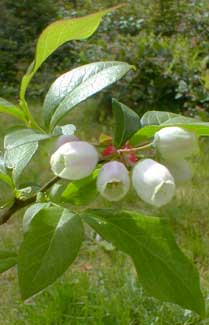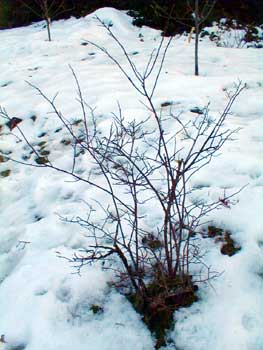
Highbush Blueberries
"In many pleasant pastures
On sunny slopes & high,
Their skins abloom with dusty blue,
Asleep, the berries lie."
-Frank Prentice Rand
(1889-1971)
(1889-1971)
Vaccinium corymbosum or North American highbush blueberry is mainly thought of as a production shrub for agricultural crops. But in fact it is one of the most ornamentally beautiful shrubs for landscaping purposes, with corymbs of white urn-flowers in late spring, dark blue summer berries as pretty as they are tasty, fabulous autumn leaf color, & shreddy bark on older shrubs interesting even in winter.
These shrubs grow six to twelve feet tall, but are usually kept pruned to around six by or five feet. It's suited for zones 4 through 8, has no invasive propensity, & is relatively easy to grow just so long as local soil & weather conditions suit it, & it does not experience drought.
The health benefits of blueberries are legendary. Extracts sold in healthfood stores are not required by law to meet any criteria for content & freshness, so should frankly be regarded as garbage. But for the fruit itself, it would be hard to overstate their merits.
 Highbush blueberries have the highest concentration of iron of any temperate fruit. They are rich in carbohydrates, low in fat, with plenty of vitamins C, K & A, as well as manganese, & a good source of dietary fibre. The scientific data is sound, & there can be no debate but that blueberry fruits & fruit juices are very rich in antioxidants & flavinoids which really do place blueberries among the healthiest fruits on earth.
Highbush blueberries have the highest concentration of iron of any temperate fruit. They are rich in carbohydrates, low in fat, with plenty of vitamins C, K & A, as well as manganese, & a good source of dietary fibre. The scientific data is sound, & there can be no debate but that blueberry fruits & fruit juices are very rich in antioxidants & flavinoids which really do place blueberries among the healthiest fruits on earth.When this fact reaches commerce, blueberries are transformed into the #1 health food on earth, & the word "blueberries!" is bannered across all sorts of products like "ala-kazam!" even if the small print reveals the product actually includes apple bits dyed blue.
In reality the array of benefits accessible from blueberries would be even greater with black currants (Ribes nigra), highbush cranberry (V. macrocarpum), or wild blueberries (Vaccinium angustifolium), or wild bilberries (V. myrtilloides). Even so, underneath the pop-literature that verges into magical thinking, there is for once a huge dose of truth to the hyperbole.
Even the claims of anti-aging properties have been shown, in peer-reviewed doubleblind independent studies, to have merit of sorts. For an overview of its specific values vs exaggerations, see the article on Antioxidants in Vacciniums. Even with the few nutty claims weeded out of the picture, the truth remains sufficiently amazing to convince anyone to start gobbling down blueberries right away.
Proper fertilizing of blueberries can be a little tricky. They evolved with shallow roots in low-nutrient acidic environments, & roots are easily burned by fertilizer. Yet to get good fruit production demands fertilizer late winter or early spring & again in late spring. But if you check five different recommendations for how to fertilize correctly, you might see five different techniques outlined.
My present recommendation, subject to amendment, is that slow release acid fertilizers that are usually thought of as more appropriate for evergreens & rhododendrons happen to serve deciduous blueberries best, too. Avoid concentrated fertilizers near the blueberries, & do not fertilize later than June, for late-year growth spurts don't serve berry production & do result in more limb-tips freezing to death in winter.
For most shrubs, tinkering with soil pH & doing constant soil readings is something the hobbiest may enjoy doing, but is wasted energy unless soil problems are really expected. Monitoring soil conditions for specific nutrient losses & to keep soil in the acid range of pH can help blueberries produce better. For instance, if there is an iron deficiency in the soil effecting the shrubs, to fertilize willynilly with a general all-purpose fertilizer can be too much for these shrubs that don't want excesses of nitrogen, but chilated iron might be an appropriate feed.
Or if there really is a nitrogen deficiency, which is not likely in our area, this could cause lower leaves to yellow & drop off prematurely, yet an all-purpose fertilizer might again have too much of the other nutrients. Or if pH fell below 4.0, liming the soil would be beneficial, but if the soil pH were already above 4.0, lime could be hazardous.
In the small blueberry patch in a client's garden, we haven't gone to any such elaborate soil testing. These shrubs do with just the late-winter & late-spring slow-release acid fertilizer, & half-composted woodchip mulch keeps the soil naturally acidic & lowish in nitrogen, without requiring soil ammendments other than the compost.
Even so, others have reported that soil-monitoring has been very useful to them. If there was a sudden drop in berry production for a formerly productive blueberry patch, I'd want soil analysis before deciding the remedy. In ordinary conditions I wouldn't expect a complete soil test to be necessary more than once in every four years & not even that often if there have never been signs of stress to suggest something might be out of kilter.
Blueberries can be stressed by a large number of factors, causing some people to have bad luck with them without quite knowing why. Insufficient sun exposure or poor watering schedule or poor soil drainage are stress factors. Poor air circulation through the shrubs can invite problems.
Their shallow root system does not like to compete with weeds or perennials, though I would risk bulbs as their companions in any blueberry patch intended to serve double-duty as ornamental landscaping in addition to fruit-baring. Early spring bulbs will be done flowering by the time the blueberries are leafing & flowering.
In zones with very cold winters, mulching the shallow roots would be essential, though not necessary here in Zone 8. If soil pH were to move toward the alkaline edge, these shrubs can decline; our native soils are naturally acidic because of good rainfall & high organic content, but if there is any chance of alkalinity, a light winter mulching with peat or autumn leaves or half-composted woodchips should be enough to preserve the requisite acidity, thus no chemical amendment ever need be imposed upon these chemical-sensitive shrubs.
Exposure to pesticides or to herbicides & sundry garden chemicals can cause the shrubs to show symptoms that resemble nutrient deficiency though it is actually only stress, so organic principles can be more than averagely effective with blueberries.
In areas where the soils are not naturally acidic it might not be worth having blueberries for ornamental purposes, as the fight to keep the pH levels can be insurmountable, given the shrubs' dislike for chemical additives. Although insufficient soil can be tricked out to perfection before planting blueberries, if the region tends naturally to be unsuited to blueberries, over time your native soil conditions will reclaim the blueberries' soil, & to attempt to re-ammend the soil with the shrubs already present rarely works to the shrubs' advantage. In our area we very happily have great soil for acid-loving shrubs, so blueberries do provide excellent ornamental perks in addition to providing health-giving tasty fruit.
Spring's new foliage is glossy green; it turns splendid colors in autumn. Late spring dangly white flowers make quite a show. Though young shrubs can be too twiggy for much of a winter impact, long-established shrubs despite their pruning requirements can have an interesting structure for winter attractiveness, especially since the limbs & twigs turn yellow or red for winter.
When first establishing shrubs, it can be worth sacrificing the fruit for the first year or the first two years. Removing the white flowers before they become berries will encourage vegetative growth necessary for future maximization of healthiness of the shrub & production of fruit. Shrubs purchased large & pot-grown can be transferred to the ground & allowed to fruit their first year, but bare-roots & young starts really do need their fruiting haulted their first two years, or the shrubs might never establish as healthy beauties.
Young bushes need minimal pruning, which can be done mainly for shape, to encourage beauty of form, & to remove any branches or tips that were damaged in winter. Fruit is produced on second-year wood, so excessive pruning should always be avoided or berry production will be unimpressive. Old stems that stop producing fruit are removed at near the ground, but it is a good idea to preserve two to four old & vigorous "trunks" & never prune those out unless they stop producing strong new shoots each year.
Many cultivars have been developed for maximum fruit production. They can produce so much fruit that they exhaust themselves with way too many flowers followed by fruits that are so numerous few if any reach full size, & ripen late, while new vegetative growth is hampered. It is thus sometimes recommended to delay pruning until the shrub is in full flower, so that part of the minimalist pruning will include removal of a percentage of the blooms, in quest of the perfect balance of fruit production & new vegatative growth.
Although a few varieties are partially self-fertile, most require cross-fertilizing with another cultivar. The patch I established has four intermingling cultivars. They are pollinated by bees & if there is a shortage of bumblebees & honey bees in the area, it is a good idea to set up some mason-bee hotels nearby. A lot of bird nesting boxes won't appeal to a lot of birds because they are territorial in the locations where they raise their young, but if "too many" bird boxes are placed near fruiting trees & shrubs, bumblebees will be apt to use them. Anything to encourage natural bee populations helps. The simple act of never using insecticides & adhering to organic principles usually does the trick.
Care of blueberries may sound a bit complicated. Compared to low-maintenance shrubs, blueberries can indeed be demanding, with rewards that are obvious. Even if ignored, however, & let to go wild & thickly woody, the loss will mainly be of heavy fruit production since the more old wood that builds up, the fewer second-year branches with berries there will be. An old poorly fruiting shrub can nevertheless have ornamental beauty to recommend it, & since no one expects a burning-bush or a wiegala to feed them, blueberry bushes too can serve this "merely" ornamental value.
It can take four years before a patch of young blueberries are mature enough to produce impressive amounts of fruits. When they are going gung-ho, it can be difficult to beat the birds to these choice berries, & it could well prove necessary to place a net over them for a short time when they are approaching full ripeness. Otherwise, the moment they are fully ripe, in our area the rufus-sided towhees will swiftly clean off the branches of all fruit. Rural gardeners may have to compete for the fruit with deer, too, if not brown bears.
Harvested fruits have a very short shelf-life & if not used within one to seven days should be vaccum-sealed & kept in the freezer. They are, however, easily sun-dried or dried in a dehydrator, after which they are immune to decay, & can be used to improve any recipe calling for raisens or currants.